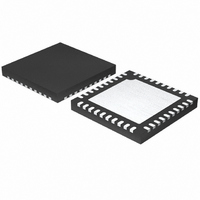MAX15035ETL+ Maxim Integrated Products, MAX15035ETL+ Datasheet - Page 22

MAX15035ETL+
Manufacturer Part Number
MAX15035ETL+
Description
IC REG STEP DOWN 15A 40-TQFN
Manufacturer
Maxim Integrated Products
Type
Step-Down (Buck)r
Datasheet
1.MAX15035ETL.pdf
(26 pages)
Specifications of MAX15035ETL+
Internal Switch(s)
Yes
Synchronous Rectifier
Yes
Number Of Outputs
1
Voltage - Output
1.05V, 1.5V
Current - Output
15A
Voltage - Input
4.5 ~ 26 V
Operating Temperature
-40°C ~ 85°C
Mounting Type
Surface Mount
Package / Case
40-TQFN Exposed Pad
Power - Output
2.16W
Lead Free Status / RoHS Status
Lead free / RoHS Compliant
Frequency - Switching
-
Lead Free Status / Rohs Status
Lead free / RoHS Compliant
15A Step-Down Regulator with Internal Switches
With most chemistries (polymer, tantalum, aluminum
electrolytic), the actual capacitance value required
relates to the physical size needed to achieve low ESR
and the chemistry limits of the selected capacitor tech-
nology. Ceramic capacitors provide low ESR, but the
capacitance and voltage rating (after derating) are
determined by the capacity needed to prevent V
and V
sients. Generally, once enough capacitance is added to
meet the overshoot requirement, undershoot at the ris-
ing load edge is no longer a problem (see the V
V
Thus, the output capacitor selection requires carefully
balancing capacitor chemistry limitations (capacitance
vs. ESR vs. voltage rating) and cost. See Figure 9.
For Quick-PWM controllers, stability is determined by the
in-phase feedback ripple relative to the switching frequen-
cy, which is typically dominated by the output ESR. The
boundary of instability is given by the following equation:
where C
total ESR of the output capacitors, R
board resistance between the output capacitors and
feedback sense point, and R
tance of the DC- or AC-coupled current-sense compen-
sation (see Figure 11).
Figure 10. Remote-Sense Compensation for Stability and Noise Immunity
22
SOAR
______________________________________________________________________________________
SOAR
equations in the Transient Response section).
OUT
Output Capacitor Stability Considerations
from causing problems during load tran-
is the total output capacitance, R
R
AGND
EFF
MAX15035
f
SW
=
π
GND
R
ESR
PGND
≥
BST
DH
LX
2
FB
IN
PWR
π
+
R
R
EFF OUT
PCB
COMP
1
C
PWR
+
R
is the effective resis-
COMP
PCB
is the parasitic
STABILITY REQUIREMENT
FEEDBACK RIPPLE IN PHASE WITH INDUCTOR CURRENT
L1
C
0.1μF
COMP
R
ESR
C
PWR
IN
ESR
C
OUT
SAG
≥
is the
2f
SAG
and
1
SW
PWR
C
OUT
AND R
INPUT
R
100Ω
COMP
COMP
For a standard 300kHz application, the effective zero
frequency must be well below 95kHz, preferably below
50kHz. With these frequency requirements, standard
tantalum and polymer capacitors already commonly
used have typical ESR zero frequencies below 50kHz,
allowing the stability requirements to be achieved with-
out any additional current-sense compensation. In the
standard application circuit (Figure 1), the ESR needed
to support a 15mV
5mΩ. Two 330μF, 9mΩ polymer capacitors in parallel
provide 4.5mΩ (max) ESR and 1/(2π x 330μF x 9mΩ) =
53kHz ESR zero frequency. See Figure 10.
Figure 9. Standard Application with Output Polymer or Tantalum
C
COMP
AGND
PWR
C
LOAD
MAX15035
≥
AGND
f
PCB PARASITIC RESISTANCE-SENSE
RESISTANCE FOR EVALUATION
SW
1
PGND
BST
LX
FB
IN
P-P
PWR
OUTPUT VOLTAGE REMOTELY
SENSED NEAR POINT OF LOAD
ripple is 15mV/(10A x 0.3) =
C
PWR
IN
OUTPUT
L1
STABILITY REQUIREMENT
R
ESR
C
OUT
≥
PWR
C
OUT
2f
1
SW
INPUT
OUTPUT








